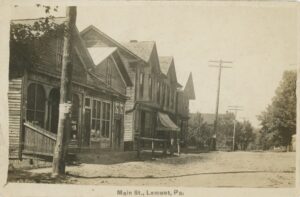Explore Centre County’s History & Culture
Welcome to the Centre County Encyclopedia of History & Culture, an online resource sponsored by the Centre County Historical Society.
Currently, we are featuring articles about Lemont and Mount Nittany. Lemont is a historic village in College Township nestled at the base of Nittany Mountain. Lemont was heavily influenced by the county's flourishing iron industry – particularly at nearby Centre Furnace – and by farming. Mount Nittany is probably the county's most famous geographical feature. The best-known section of the ridge is its southwestern terminus, separating Nittany Valley from the Penns and Brush valleys.
We welcome your feedback about all the articles in the encyclopedia as well as your suggestions for future encyclopedia articles.
Featured Articles
Lemont is a historic village in College Township nestled at the base of Nittany Mountain. Traditionally known as “The End of the Mountain,” it slowly grew as a settlement in the early 1800s as an important crossroads connecting the Nittany and Penns valleys.
Learn More>>Mount Nittany is probably Centre County’s most famous geographical feature. Thanks to the Penn State football team, fans across the country are familiar with the name of the iconic ridge. As a result, Mount Nittany has become an integral part of the lore of the school and region.
Learn More>>See What's New
At least twenty-eight Black men from Centre County served in the U.S. Colored Troops during the Civil War. Their experiences provide insight into the recruitment of the North’s Free Blacks into the army during the war.
Learn More>>College Heights is a residential neighborhood in State College that was originally developed to provide housing for Penn State faculty, staff, and students. Much of the neighborhood is included in a National Register Historic District.
Learn More>>Julia Gregg Brill was the first female professor in Penn State’s English Department where she taught composition from 1924 to 1954. She was a tireless advocate for women and recognized by the university for her work.
Learn More>>Robert Cole was a self-trained architect who designed some of Bellefonte’s best-known buildings, as well as churches, homes and other structures in Centre County.
Learn More>>


